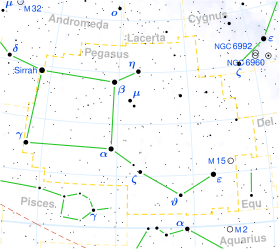35 Pegasi
| Observation data Epoch J2000 Equinox J2000 | |
|---|---|
| Constellation | Pegasus |
| Right ascension | 22h 27m 51.52245s[1] |
| Declination | 4° 41′ 44.4005″[1] |
| Apparent magnitude (V) | 4.80[2] |
| Characteristics | |
| Spectral type | K0III[3] |
| U−B color index | +0.88[2] |
| B−V color index | +1.06[2] |
| Astrometry | |
| Radial velocity (Rv) | +54.16[4] km/s |
| Proper motion (μ) | RA: +77.57[1] mas/yr Dec.: -306.12[1] mas/yr |
| Parallax (π) | 21.99 ± 0.37[1] mas |
| Distance | 148 ± 2 ly (45.5 ± 0.8 pc) |
| Absolute magnitude (MV) | 1.50[5] |
| Details | |
| Mass | 1.18[5] M☉ |
| Radius | 8.5[6] R☉ |
| Luminosity | 31.69[7] L☉ |
| Surface gravity (log g) | 2.76[8] cgs |
| Temperature | 4,676[8] K |
| Metallicity [Fe/H] | -0.28[8] dex |
| Rotational velocity (v sin i) | < 1.0[9] km/s |
| Other designations | |
| Database references | |
| SIMBAD | data |
35 Pegasi (35 Peg) is a class K0III[3] (orange giant) star in the constellation Pegasus. Its apparent magnitude is 4.80[2] and it is approximately 148 light years away based on parallax.[1]
In addition to the primary, there are two distant companions: B, at separation 80.5" and magnitude 10.0, and C, at separation 176.3" and magnitude 10.64.[10]
References
- 1 2 3 4 5 6 Van Leeuwen, F. (2007). "Validation of the new Hipparcos reduction". Astronomy and Astrophysics. 474 (2): 653. arXiv:0708.1752. Bibcode:2007A&A...474..653V. doi:10.1051/0004-6361:20078357. Vizier catalog entry
- 1 2 3 4 Ducati, J. R. (2002). "VizieR Online Data Catalog: Catalogue of Stellar Photometry in Johnson's 11-color system". CDS/ADC Collection of Electronic Catalogues. 2237. Bibcode:2002yCat.2237....0D.
- 1 2 Hoffleit, D.; Warren, W. H. (1995). "VizieR Online Data Catalog: Bright Star Catalogue, 5th Revised Ed. (Hoffleit+, 1991)". VizieR On-line Data Catalog: V/50. Originally published in: 1964BS....C......0H. 5050. Bibcode:1995yCat.5050....0H.
- ↑ Famaey, B.; Jorissen, A.; Luri, X.; Mayor, M.; Udry, S.; Dejonghe, H.; Turon, C. (2005). "Local kinematics of K and M giants from CORAVEL/Hipparcos/Tycho-2 data". Astronomy & Astrophysics. 430: 165. arXiv:astro-ph/0409579. Bibcode:2005A&A...430..165F. doi:10.1051/0004-6361:20041272.
- 1 2 Da Silva, Ronaldo; Milone, André de C.; Rocha-Pinto, Helio J. (2015). "Homogeneous abundance analysis of FGK dwarf, subgiant, and giant stars with and without giant planets". Astronomy & Astrophysics. 580: A24. Bibcode:2015A&A...580A..24D. doi:10.1051/0004-6361/201525770. Vizier catalog entry
- ↑ Allende Prieto, C.; Lambert, D. L. (1999). "Fundamental parameters of nearby stars from the comparison with evolutionary calculations: Masses, radii and effective temperatures". Astronomy and Astrophysics. 352: 555. arXiv:astro-ph/9911002. Bibcode:1999A&A...352..555A. Vizier catalog entry
- ↑ Anderson, E.; Francis, Ch. (2012). "XHIP: An extended hipparcos compilation". Astronomy Letters. 38 (5): 331. arXiv:1108.4971. Bibcode:2012AstL...38..331A. doi:10.1134/S1063773712050015. Vizier catalog entry
- 1 2 3 Wu, Yue; Singh, H. P.; Prugniel, P.; Gupta, R.; Koleva, M. (2010). "Coudé-feed stellar spectral library – atmospheric parameters". Astronomy & Astrophysics. 525: A71. arXiv:1009.1491. Bibcode:2011A&A...525A..71W. doi:10.1051/0004-6361/201015014.
- ↑ De Medeiros, J. R.; Mayor, M. (1999). "A catalog of rotational and radial velocities for evolved stars". Astronomy and Astrophysics Supplement Series. 139 (3): 433. arXiv:astro-ph/0608248. Bibcode:1999A&AS..139..433D. doi:10.1051/aas:1999401. Vizier catalog entry
- ↑ Mason, Brian D.; Wycoff, Gary L.; Hartkopf, William I.; Douglass, Geoffrey G.; Worley, Charles E. (2001). "The 2001 US Naval Observatory Double Star CD-ROM. I. The Washington Double Star Catalog". The Astronomical Journal. 122 (6): 3466. Bibcode:2001AJ....122.3466M. doi:10.1086/323920. Vizier catalog entry
This article is issued from
Wikipedia.
The text is licensed under Creative Commons - Attribution - Sharealike.
Additional terms may apply for the media files.
